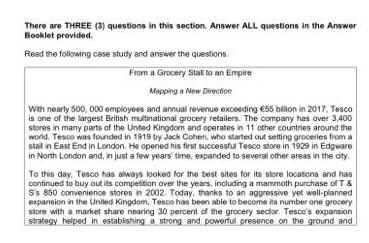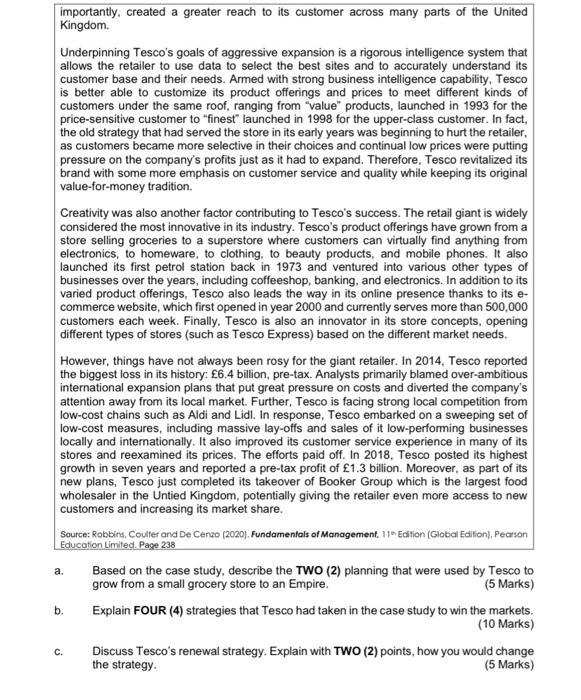Answered step by step
Verified Expert Solution
Question
1 Approved Answer
There are THREE (3) questions in this section. Answer ALL questions in the Answer Booklet provided. Read the following case study and answer the


There are THREE (3) questions in this section. Answer ALL questions in the Answer Booklet provided. Read the following case study and answer the questions. From a Grocery Stall to an Empire Mapping a New Direction With nearly 500, 000 employees and annual revenue exceeding 55 billion in 2017. Tesco is one of the largest British multinational grocery retailers. The company has over 3,400 stores in many parts of the United Kingdom and operates in 11 other countries around the world. Tesco was founded in 1919 by Jack Cohen, who started out setting groceries from a stail in East End in London. He opened his first successful Tesco store in 1929 in Edgware in North London and, in just a few years' time, expanded to several other areas in the city. To this day, Tesco has always looked for the best sites for its store locations and has continued to buy out its competition over the years, including a mammoth purchase of T & S's 850 convenience stores in 2002. Today, thanks to an aggressive yet well-planned expansion in the United Kingdom, Tesco has been able to become its number one grocery store with a market share nearing 30 percent of the grocery sector. Tesco's expansion strategy helped in establishing a strong and powerful presence on the ground and importantly, created a greater reach to its customer across many parts of the United Kingdom. Underpinning Tesco's goals of aggressive expansion is a rigorous intelligence system that allows the retailer to use data to select the best sites and to accurately understand its customer base and their needs. Armed with strong business intelligence capability, Tesco is better able to customize its product offerings and prices to meet different kinds of customers under the same roof, ranging from "value" products, launched in 1993 for the price-sensitive customer to "finest" launched in 1998 for the upper-class customer. In fact, the old strategy that had served the store in its early years was beginning to hurt the retailer, as customers became more selective in their choices and continual low prices were putting pressure on the company's profits just as it had to expand. Therefore, Tesco revitalized its brand with some more emphasis on customer service and quality while keeping its original value-for-money tradition. Creativity was also another factor contributing to Tesco's success. The retail giant is widely considered the most innovative in its industry. Tesco's product offerings have grown from a store selling groceries to a superstore where customers can virtually find anything from electronics, to homeware, to clothing, to beauty products, and mobile phones. It also launched its first petrol station back in 1973 and ventured into various other types of businesses over the years, including coffeeshop, banking, and electronics. In addition to its varied product offerings, Tesco also leads the way in its online presence thanks to its e- commerce website, which first opened in year 2000 and currently serves more than 500,000 customers each week. Finally. Tesco is also an innovator in its store concepts, opening different types of stores (such as Tesco Express) based on the different market needs. However, things have not always been rosy for the giant retailer. In 2014, Tesco reported the biggest loss in its history: 6.4 billion, pre-tax. Analysts primarily blamed over-ambitious international expansion plans that put great pressure on costs and diverted the company's attention away from its local market. Further, Tesco is facing strong local competition from low-cost chains such as Aldi and Lidl. In response, Tesco embarked on a sweeping set of low-cost measures, including massive lay-offs and sales of it low-performing businesses locally and internationally. It also improved its customer service experience in many of its stores and reexamined its prices. The efforts paid off. In 2018, Tesco posted its highest growth in seven years and reported a pre-tax profit of 1.3 billion. Moreover, as part of its new plans, Tesco just completed its takeover of Booker Group which is the largest food wholesaler in the Untied Kingdom, potentially giving the retailer even more access to new customers and increasing its market share. Source: Robbins, Coulter and De Cenzo (2020). Fundamentals of Management, 11 Edition (Global Edition), Pearson Education Limited, Page 238 a. b. C. Based on the case study, describe the TWO (2) planning that were used by Tesco to grow from a small grocery store to an Empire. (5 Marks) Explain FOUR (4) strategies that Tesco had taken in the case study to win the markets. (10 Marks) Discuss Tesco's renewal strategy. Explain with TWO (2) points, how you would change the strategy. (5 Marks)
Step by Step Solution
★★★★★
3.56 Rating (163 Votes )
There are 3 Steps involved in it
Step: 1
a Based on the case study describe the TWO 2 planning that were used by Tesco to grow from a small g...
Get Instant Access to Expert-Tailored Solutions
See step-by-step solutions with expert insights and AI powered tools for academic success
Step: 2

Step: 3

Ace Your Homework with AI
Get the answers you need in no time with our AI-driven, step-by-step assistance
Get Started


